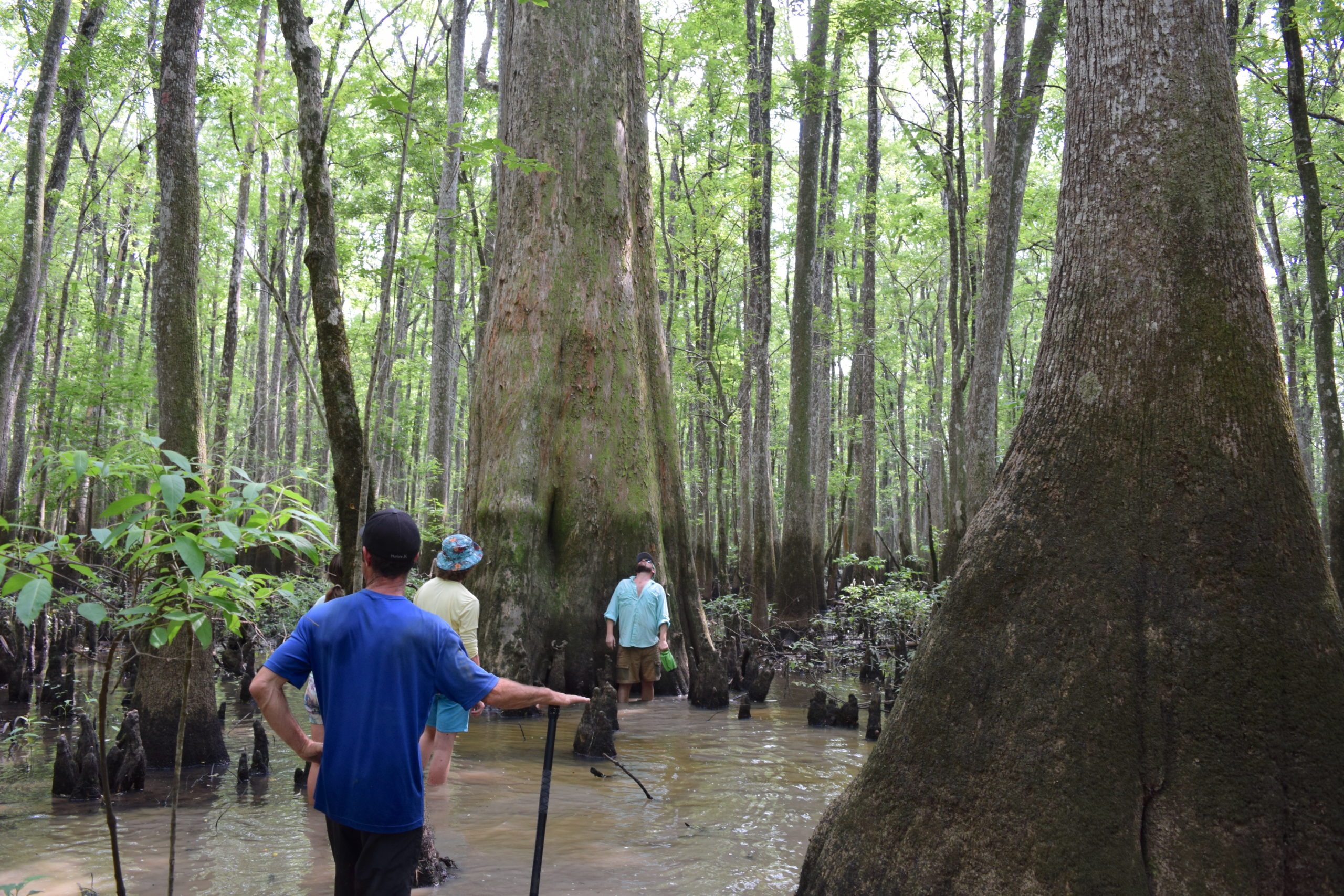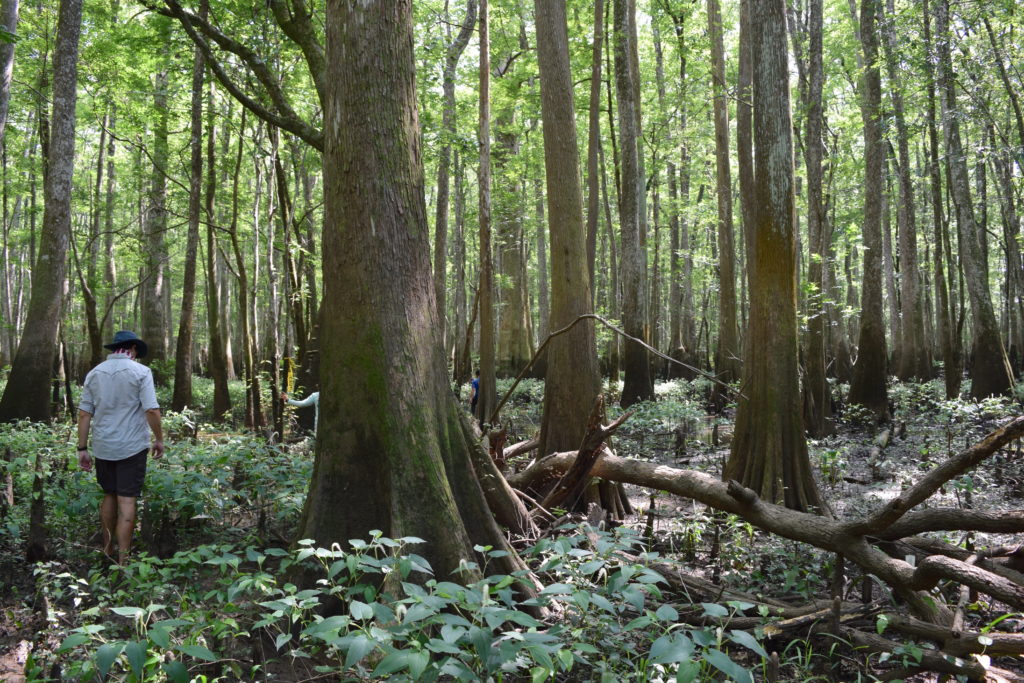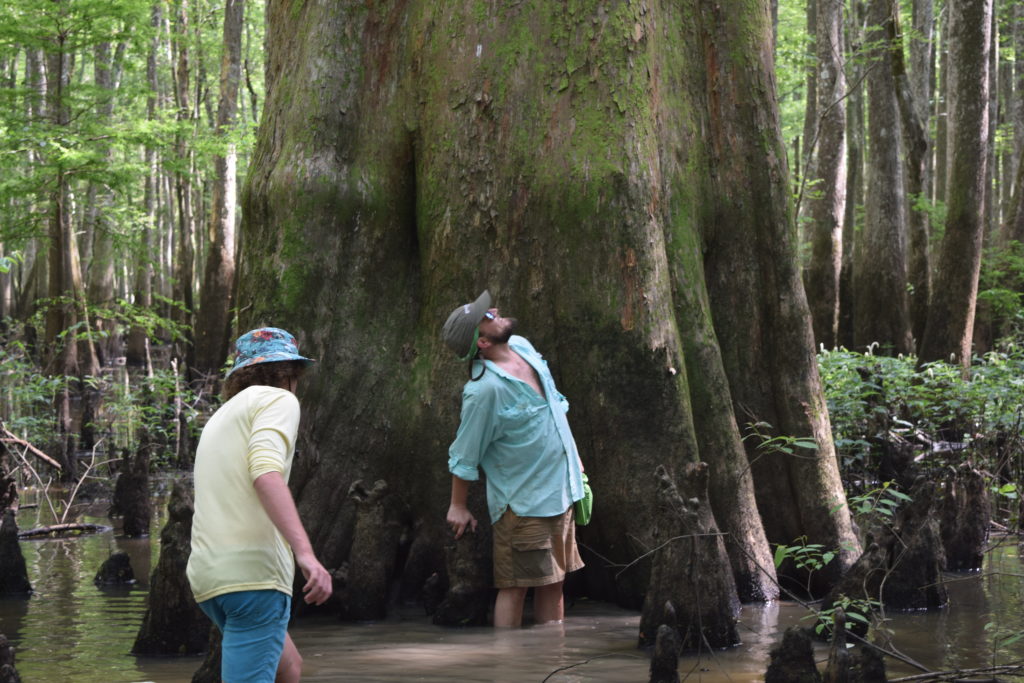
This article is from the fall edition of Mobile Baykeeper’s print quarterly, CURRENTS. The magazine is mailed to active members who have given more than $50 in 2023. To get on the magazine’s mailing list, donate here.
by Sam Wilkes | Photos by Edward Denton
Centuries ago, dense forests of enormous oaks, pines, and cypress trees covered lower Alabama. Giants that would dwarf the typical trees we encounter today. Some say the Spanish explorers looked to the massive stands of cypress trees as navigation beacons when entering Mobile Bay. A sight on the horizon we could only dream of, as now there is but one of these giant cypress trees remaining, hidden deep within the Delta marsh, surrounded by a brigade of cypress knees. And the only way to reach her is by water.
As we kayaked back from our excursion to Mound Island (see “Escape to Mound Island” in the 2nd Edition of CURRENTS), we had enough sunlight left to visit Alabama’s Champion Cypress. Alabama’s Champion Tree Program began in 1970, modeled after the American Forest’s “Big Tree” Program. The registry is designed to discover, recognize, and preserve the largest of each native tree species in the state. The point system is based on circumference, height, and average crown spread. At its inception, 28 trees were listed. As of 2017, there were 159 Champion trees of 143 different species. Alabama’s Champion Cypress is listed as the state’s second-largest tree overall. The Southern Live Oak, located at the intersection of Highway 43 and Dead Lake Road in Creola, ranked bigger only in terms of width of the trunk, but the Champion Cypress stands nearly twice as tall.
Located in the woods just off the trail home, we fortunately did not have to paddle out of our way. We let the obliging currents do most of the heavy lifting. With one paddle stroke, our boats glided effortlessly along the narrow curves of Bayou Jessamine. I relaxed my blistered hands from the hours of paddling and took in the beauty of the nation’s second largest river delta.
“It is arguably the biologically richest place,” E.O. Wilson once said. “It has more species of plants and animals than any comparable area in North America … it is a place yet completely unexplored, sort of like the upper Amazon.”
An Osprey chirped overhead, concealed above the thick canopy. Choctaw Spider-Lilies gently swayed in unison on the creek banks. White and grey oyster mushrooms clustered underneath leaning oaks, beaming in the daylight. Hundreds of water beetles skated about on the surface. As we leisurely floated, Chris Wiber, our guide with WildNative, told us about his favorite Delta wildflower, the Pickerelweed. With upright purple spiky blooms, they appeared like stalks of rock candy on the shoreline. But Chris’s favorite part was not necessarily the flower itself, but “the Pickerel Bee that devotes its life to this flower’s nectar,” he said. They’re tiny bees but equipped with long tongues to access the nectar.
“These solitary bees build their nest underground right next to the plant,” Chris added. “They produce one generation per year and coordinate their arrival with the flower’s first bloom.” A fascinating relationship perfected through time and evolution that one cannot help but respect.
Then Chris slowed his kayak. “I think this is it. Hold here. I’m going to do some scouting,” he said as we paddled up to a nondescript section of the creek.

There were no convenient markers for the Champion Cypress. One must know what they’re looking for. I’m not sure what led Chris to stop at that part of Bayou Jessamine — a part that looked almost identical to the other several miles of creek bank — but he seemed to focus on a distinct cluster of cypress knees. He slid off his sandals and pulled out a large spool of yellow and black caution tape. My thoughts went to a crime scene, until Chris explained how the bright tape made for great trail-markers so he could find his way back. Even the experienced do not have to venture far into this unyielding menagerie to get lost.
“If I’m not back in thirty, wait longer,” he joked as he entered the dense vegetation, steadily vanishing from sight.
We waited in our kayaks, holding a rope tethered to a tree. One of Chris’s assistants stalked a wolf spider on the other side of the bank, attempting to get a photograph. Fifteen minutes felt like an hour. We joked about divvying up Chris’s belongings as the shaded Delta canopy grew even darker under the passing clouds.
Then we heard a voice calling out from the woods. “Found her!”
We climbed out of our boats and prepared for a short hike. Sometimes in the wet season of January through April, you can paddle right up to the giant’s trunk as the area is typically flooded. On the contrary, in the dry fall season, one can leave their kayak at the creek and easily walk over the firm ground to the site. We did not have either of those luxuries.
We had a half-mile trek through knee-deep water with an aggressive mud bottom that acted more like quicksand. I made the unwise decision of keeping my sandals on. But the sucking mud wanted a sacrifice. Each step was a gamble into the murky unknown, where I feared I’d either lose a sandal or an ankle. I had never appreciated a simple walking stick more than during that hike.
Wabbling along, I kept my head down, watching my steps and making sure I still had a foot attached. Then, before realizing I was in her presence, her legion of cypress knees appeared. Hundreds of them, spanning a radius around the giant like knotty mud minions rising from the swamp, guarding their queen. The purpose of the cypress knee has long puzzled botanists. Strange root structures that grow at right angles to the soil but appear several feet away from the tree itself. Most hypothesize that they help aerate the tree’s root system, similar to a swimmer’s snorkel, while some believe they also provide structural reinforcement, capture sediment, and help fight erosion. Yet, no definitive explanation has been accepted. Regardless of the scientific purpose, in that moment, their knotty support helped me stay upright.
“Holy mother, she’s gorgeous,” someone gasped.
I looked up and followed their gaze. Once I saw the trunk, there was no mistaking the Champion, as she eclipsed the younger cypress trees spread throughout the area. She is 27 feet around the base, soaking in the rising Delta water. Local biologists estimate she is somewhere between 200 and 300 years old, and she has the scars to show it. Black holes from century-old borings pepper her side, revealing her hollow interior. There is roughly one hundred feet of trunk until the cypress fronds bloom high within the canopy. It is another 12 feet to reach her blunted-off top portion, which was possibly damaged by lightning strikes over the years. Because when you’re the largest in the crowd, you tend to stand out.

But local biologists believe those defects and scars likely saved her life. For in the mid-1800s, the large longleaf pine and cypress forests of lower Alabama began falling to the timber industry. The highly valuable inner layer of heartwood in the cypress trees was prized for shipbuilding due to its durable rot-resistant properties. But a hollow cypress lacks valuable heartwood. So, the timber scouts passed over this one. She wasn’t worth the trouble to cut down.
“The cause of the tree being hollow is not due to an insect or parasite; it’s a natural process that can happen to some as the tree ages,” explained Valerie Longe, Mobile Baykeeper’s education director and a former WildNative guide. “The center can erode, while the outer layers at the base of the trunk continue to support it.”
In awe, I lumbered my way to the base and ran my hand along the fibrous bark. Something about the size and shape gave the sense I was approaching the leg of a Brachiosaurus. Or some other wild mammoth. I half expected her to let out a deep bellow. I moved in closer and stared straight up, imagining myself as an ant walking up the 112 feet, not realizing my entire world was but a single tree. I wanted to climb to the top and view the expanse of the Mobile River Basin. But I couldn’t even see the top from my vantage point, just an infinite line of moss-covered bark with distant fronds. The sounds of the afternoon Delta enveloped us. I stayed there for several minutes, just breathing.
On the hike back, we looked for the highlighter-yellow of the caution tape to find our path. I would likely still be there if it were not for that tape. Chris stayed behind and gathered each piece, removing our breadcrumbs as if we were never there.
“The average lifespan of a Bald Cypress is 600 years,” said Valerie. “But they can live even longer. There is one in North Carolina surpassing 2,600 years.”
In July of 1999, several conservation-focused state agencies pooled together funds and purchased 50,000 acres in the Mobile-Tensaw River Delta, closing this area off from development and preserving it for public use and enjoyment. Although it’s not likely our Champion Cypress will live another 1,000 years, it’s refreshing to think she at least has a fighting chance. Guess sometimes it pays to be worthless.
